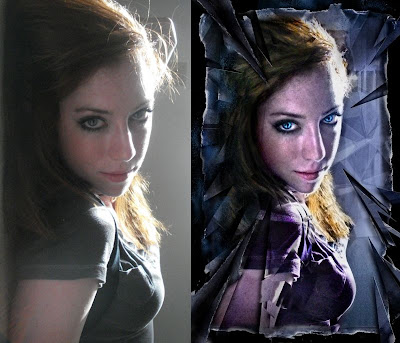
Richland Multimedia Student Phat Du has received a full tuition Graphic Design scholarship at Texas Christian University! Phat answered a few questions for us:
Q: So I heard you just got some scholarship to TCU, can you tell me more about it?
A: Texas Christian University in Fort Worth offered me a full tuition to join their Graphic Design program for 3 years, starting in January. I’m really excited about it. Their football team got
really good this year.
Q: How did you get this scholarship?
A: Well, they looked at my college essay, my letters of recommendation which were written by Dr. Sherry Dean and ex-gallery director Randall Garrett from the Fine Arts and Humanities department, then my resume including leadership of the Student Visual Arts Club, awards such as Photoshop World scholarship, runner up for student category 4th Annual Photoshopuser Awards, 1st place digital art category Richland Annual Art 07-08 and 08-09, exhibitions from the Computer Arts Festival, etc.
Q: That’s cool! They must really like your portfolio!
A: That’s a statement not a question.
Q: Sorry, did they look at your portfolio as well?
A: Yes, but that was after the scholarship. They wanted to make sure my classes are good enough to transfer. TCU grad alumni, new Richland gallery director, Ryder Richards took me there last month to do the portfolio review. It was a fun trip.
Q: Any other comments?
A: I would like to thank Richland Multimedia Department for providing me a strong foundation with their challenging courses, the long-open-hour lab where I built most of my art works. Special thanks to Mr. Dwayne Carter for his help with the art club and letting me use the school’s equipments, Mrs. Debbie Smith, Noah and Matt for their laughs and humors, Miss Marry Benedicto for the ride home at nights earlier this year. Lastly, I hope my story will be an inspiring legacy for future students at Richland.
Q: So I heard you just got some scholarship to TCU, can you tell me more about it?
A: Texas Christian University in Fort Worth offered me a full tuition to join their Graphic Design program for 3 years, starting in January. I’m really excited about it. Their football team got
really good this year.
Q: How did you get this scholarship?
A: Well, they looked at my college essay, my letters of recommendation which were written by Dr. Sherry Dean and ex-gallery director Randall Garrett from the Fine Arts and Humanities department, then my resume including leadership of the Student Visual Arts Club, awards such as Photoshop World scholarship, runner up for student category 4th Annual Photoshopuser Awards, 1st place digital art category Richland Annual Art 07-08 and 08-09, exhibitions from the Computer Arts Festival, etc.
Q: That’s cool! They must really like your portfolio!
A: That’s a statement not a question.
Q: Sorry, did they look at your portfolio as well?
A: Yes, but that was after the scholarship. They wanted to make sure my classes are good enough to transfer. TCU grad alumni, new Richland gallery director, Ryder Richards took me there last month to do the portfolio review. It was a fun trip.
Q: Any other comments?
A: I would like to thank Richland Multimedia Department for providing me a strong foundation with their challenging courses, the long-open-hour lab where I built most of my art works. Special thanks to Mr. Dwayne Carter for his help with the art club and letting me use the school’s equipments, Mrs. Debbie Smith, Noah and Matt for their laughs and humors, Miss Marry Benedicto for the ride home at nights earlier this year. Lastly, I hope my story will be an inspiring legacy for future students at Richland.
Congratulations, Phat!





